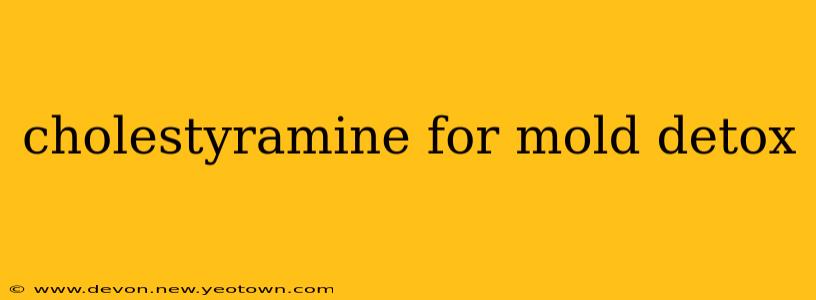Mold exposure can wreak havoc on your health, triggering a cascade of symptoms ranging from respiratory issues to debilitating fatigue. For those struggling with persistent symptoms despite other treatments, the idea of using cholestyramine for mold detoxification has gained traction. But is there any scientific backing to this approach? Let's delve into the complexities of this controversial treatment.
My name is Dr. Evelyn Reed, and I've spent years researching the impact of mycotoxins (toxins produced by mold) on human health. While I'm not advocating for or against cholestyramine for mold detox without proper medical supervision, I aim to provide you with an unbiased, evidence-based exploration of this topic.
What is Cholestyramine?
Cholestyramine is a medication primarily used to lower cholesterol levels. It works by binding to bile acids in the digestive tract, preventing their reabsorption. This binding action is where the potential mold detox application comes into play. Some proponents suggest that cholestyramine can bind to mycotoxins in a similar manner, helping to eliminate them from the body.
Can Cholestyramine Bind to Mycotoxins? The Science Behind the Claim
This is where the science gets murky. While cholestyramine demonstrably binds to bile acids, its ability to effectively bind and eliminate various mycotoxins remains largely unproven. Many mycotoxins have different chemical structures than bile acids, making their interaction with cholestyramine unpredictable. Furthermore, the concentration of mycotoxins needed to trigger symptoms often surpasses what cholestyramine might realistically bind in the gut.
Does cholestyramine remove mycotoxins from the body?
The answer, based on current research, is inconclusive. While in vitro (test tube) studies might show some binding capacity, this doesn't translate to the same efficacy in vivo (in a living organism). The human body is incredibly complex, and the interaction of cholestyramine with mycotoxins is likely influenced by many factors, including the specific type of mycotoxin, gut microbiota, and overall health. Rigorous clinical trials are needed to definitively establish its effectiveness in mycotoxin removal.
Is cholestyramine safe for mold detoxification?
Cholestyramine, like any medication, carries potential side effects. These can include constipation, nausea, abdominal pain, and vitamin deficiencies (due to interference with fat-soluble vitamin absorption). Self-medicating with cholestyramine for mold detoxification without consulting a healthcare professional is strongly discouraged. A doctor can assess your individual health status and determine if the potential risks outweigh the perceived benefits.
What are the other treatments for mold toxicity?
Treatment for mold-related illness is complex and individualized. It often focuses on identifying and removing the mold source, improving air quality, and addressing specific symptoms. This may involve various approaches, including:
- Air purification: Using HEPA filters to remove mold spores from the air.
- Environmental remediation: Professional mold removal and cleanup services.
- Symptom management: Addressing specific symptoms like respiratory problems, fatigue, or headaches with appropriate medications and therapies.
- Supportive therapies: This might include dietary changes, detoxification support (under medical supervision), and stress reduction techniques.
What are the side effects of cholestyramine?
As mentioned before, constipation is a very common side effect. Other potential side effects include:
- Nausea
- Vomiting
- Abdominal cramping
- Bloating
- Vitamin deficiencies (especially fat-soluble vitamins A, D, E, and K)
Conclusion: Proceed with Caution
The use of cholestyramine for mold detoxification is not yet supported by robust scientific evidence. While some anecdotal reports suggest potential benefits, these lack the rigor of controlled clinical trials. Always consult a qualified healthcare professional before considering any treatment for mold-related illness, including cholestyramine. They can assess your specific situation, discuss potential risks and benefits, and recommend the most appropriate course of action. Remember, treating mold-related illness requires a holistic approach that addresses both the environmental triggers and the individual's health. Focus on eliminating the source of exposure and supporting your overall well-being.

